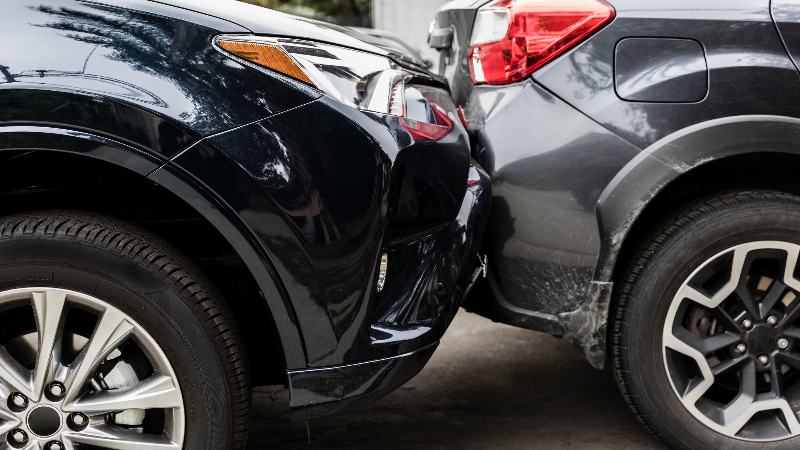Key takeaways
- Car insurance fraud costs billions annually and surged during the pandemic, with common schemes including staged accidents and billing scams.
- Nevada has more auto-related fraud than any other state.
- Various types of fraud, such as counterfeit airbags, windshield replacement and staged accidents, pose risks to drivers, necessitating caution and awareness to avoid falling victim to these scams.
Each year, insurance fraud causes significant financial burdens on both auto insurers and consumers, amounting to billions of dollars in losses. The FBI estimates that insurance fraud costs the average family between $400 to $700 every year on their premiums. A 2022 study from The Coalition Against Insurance Fraud found insurance fraud costs Americans more than $308 billion yearly, and auto insurance fraud is a major contributor. According to the Coalition Against Insurance Fraud, nearly seven in 10 consumers are unaware of insurance fraud schemes, leaving them susceptible to falling victim to them.
What is car insurance fraud?
Car insurance fraud is what occurs when someone lies or makes an omission to get a better insurance rate or receive a larger claim payout. Car insurance fraud examples could include a simple lie, like listing a false ZIP code on your policy information to get a lower rate, or something as serious as deliberately causing an accident to receive an insurance payout. These types of fraud are sometimes called “premium leakage.”
Insurance fraud impacts millions of people across the U.S., including those who have never directly been involved in a scam. A study from Verisk found that premium leakage costs insurers as much as $29 billion per year. That cost to insurers often gets passed on to drivers, who pay higher premiums as a result. About one-third of all drivers think they’ve been the victim of insurance fraud, including almost half of all Millennials. Unfortunately, insurance scams are just one type of auto fraud. According to a 2021 study using data from the FTC, Nevada is the worst state for auto-related fraud cases, with just over 346 cases per 1 million drivers. These cases include deceptive claims regarding auto prices and warranties, exaggerated repair costs, and dissatisfaction with auto repairs.
According to Jim Quiggle, communications director for the Coalition Against Insurance Fraud (CAIF), insurance fraud is a “major league crime involving a wide variety of schemes.” Even as an everyday driver, it could help to know what it looks like.
6 Common types of car insurance fraud
Insurance fraud can victimize unsuspecting drivers who don’t realize they are dealing with a dishonest agent or repair garage. However, sometimes drivers are the party at fault for committing fraud by lying to an insurer. Below are just six of the most common types of auto-related insurance fraud.
1. Counterfeit airbags
Airbags have saved more than 50,000 lives since they were introduced, according to a study from the National Highway Traffic Safety Administration (NHTSA), making them a key tool for ensuring driver and passenger safety. However, after an accident, there are occasional instances in which deployed airbags are replaced with counterfeits during the repair process. This can put people’s lives at risk.
While the NHTSA says that counterfeit airbags are rare — it estimates that fake airbags represent less than 0.1 percent of what is installed in U.S. vehicles — they bring a high likelihood of malfunction, and risk of explosion and metal shrapnel make them a danger to drivers and vehicle occupants.
The ease of online shopping, such as through platforms like eBay, has facilitated the proliferation of counterfeit airbags. Additionally, certain repair shops seeking higher profits have knowingly opted for cheaper, illegal airbag replacements. These actions jeopardize vehicle safety, as substandard airbags may fail to deploy properly in the event of an accident. “Crooked repair shops frequently replace the bags with cheap knockoffs, or in some cases just fill the area with junk and garbage,” says Quiggle. “The insurer pays for phony work and the driver ends up with a car that isn’t safe.”
The National Highway Traffic Safety Administration (NHTSA) has identified several car makes and models affected by the Takata airbag recall, totaling approximately 67 million potential counterfeit airbags. To check for recalls, enter your car’s VIN on the NHTSA website.
When purchasing a used car, take precautions to prevent counterfeit airbag installation:
- Obtain a vehicle report from Carfax or other accident history report
- Ensure the airbag light functions correctly by checking for the airbag light on the dashboard
- Have the vehicle inspected by the manufacturer, especially if the airbags were replaced by an independent repair shop in the past three years.
Some states, like California, have passed laws making it illegal to replace an airbag with a faulty one. The penalty for this fraud can land the perpetrator a year in prison and up to $5,000 in fines.
2. Staged accidents
The National Insurance Crime Bureau (NICB) referred to staged accidents as a “big business” that drivers should know how to spot and handle. They include any incidents where a driver intentionally or strategically causes a collision with another vehicle to receive a fraudulent insurance payout. The incident’s facts are often inflated or misrepresented to result in the unsuspecting driver being at fault.
Staged accident claims may result in claims ranging from $2,000-$10,000, but some fraud rings may work collectively to receive even more, resulting in hundreds of thousands of dollars in total. For policyholders in South Carolina, which ranked seventh in the nation for most staged accidents, these schemes caused premium increases of around 8.9 percent across 10 major providers in the state. The FBI estimates that staged accidents cost insurance companies as much as $20 billion per year. According to the Coalition Against Insurance Fraud, it is estimated that staged accidents account for about 10 percent of losses related to property damage or injury.
NICB says common types of staged crashes include:
- Swoop and squat: Two vehicles trap a victim and force them into a rear-end collision.
- Drive down: While waiting to make a left turn, the victim is tricked into turning early by an oncoming driver who waits to lure the driver to move forward, then collides with the victim.
- Wave down: Two vehicles set up a crash with a victim by waving to the victim that it is safe to pull out of a parking lot or side street with obscured vision.
- Enhanced damages: After a legitimate accident, the driver who is not at fault causes additional damage to their vehicle to increase the cost of the claim.
- Panic stop: A vehicle strategically prompts the distracted trailing car to rear-end them by abruptly braking.
- Sideswipe: A driver maneuvers to sideswipe another vehicle in the inner left-turn lane of a dual left-turn lane intersection.
If you ever suspect you are part of a staged accident, the NICB recommends that you document the extent of damage and the number of passengers involved in case false claims are made. Additionally, it is recommended that you be wary of individuals offering advice and services that were not requested, including post-accident medical or legal advice and towing services.
3. Agent fraud
Most insurance professionals are honest, but if you buy your car insurance coverage through an agent who has the potential to commit car insurance fraud, it can cost you.
CAIF says one of the worst-case scenarios involves a dishonest insurance professional who steals your premiums. The unscrupulous agent pockets your money and doesn’t set up the coverage, so when an accident occurs, you find that you have no insurance to pay your claim and must cover the loss on your own. This is sometimes called premium diversion, and the FBI says it is one of the most common forms of insurance fraud.
Another common practice is known as “sliding,” in which an unethical agent slips extra coverage that you didn’t want into your policy. This particularly sneaky form of auto insurance fraud can add a few hundred dollars a year to your premiums while padding the agent’s commission. Vigilant drivers who investigate their agents ahead of time and keep a close eye on what they’re buying are less likely to fall victim to sliding scams.
To avoid premium theft, drivers should work with trusted agents and always verify their coverage independently with the insurer. Some ways you could go about finding a trusted agent include:
- Ask for references: To gauge the agent’s professional standing, consider requesting references to ensure their established track record.
- Confirm the agent’s license: You can validate an insurance agent’s license by checking your state’s license database or utilizing the National Association of Insurance Commissioners’ (NAIC) Insurance Agent/Broker Search Tool.
- Compare advice: Similar to comparing car insurance quotes, it may be beneficial to seek advice from multiple agents to assess their recommendations. If an agent’s guidance differs significantly from that of others, it’s worth questioning the reliability of the information provided.
- Research complaints: An insurance agent with good standing will typically have accessible information about their professional background. While conducting your research, also explore whether any complaints have been lodged against them and how serious those claims are.
4. Windshield replacement rip-offs
Windshield replacement deductibles may vary by state, insurer and policy. However, three states — Florida, Kentucky and South Carolina — do not allow insurance companies to charge a deductible for windshield replacement. Unscrupulous glass replacement contractors in these states have used this as an opportunity to trick customers into having their windshields replaced even if minimal damage is present.
This scam is especially prevalent in Florida. Drivers are approached randomly at car washes, gas stations and shopping centers and enticed with gift cards to sign a false Assignment of Benefits (AOB), allowing the shady vendor to handle the repair and claim process with the insurer. AOB for windshield glass was prohibited by the 2023 Florida Senate Bill 2A. However, unscrupulous actors continue to prey on Florida drivers by using quasi-AOB agreements called a “Direction to Pay” agreement, which allows the contractor to handle the glass claim.
This can lead to six-figure settlements for a simple windshield repair that should have only cost $200-$300. Nearly 27,000 AOB windshield repair lawsuits were filed against Florida auto insurers in 2020, according to the Florida Justice Reform Institute. The National Insurance Crime Bureau tracked an increase of 8,650 percent in windshield replacement scams in Florida between 2006 and 2019. The problem has only continued to worsen. The Florida Department of Financial Services reported 46,000 auto glass lawsuits filed in 2023.
According to Farmers Insurance, the windshield replacement offer is almost always a scam. And the risks may be more significant than many people realize. First, the quality of the replacement windshield and the repair work usually is subpar, which means you could be putting your safety at risk when driving your vehicle. This scam can also do a number on your insurance coverage, says Quiggle, as it could lead to increased rates or policy nonrenewal.
Experts say the best thing is to walk away from the offer. If you need your windshield replaced, contact your insurance agent or carrier and report the loss. They will verify coverage and arrange a legitimate vendor, such as Safelite (which is contracted with many national and regional insurers), to come to your home or business to repair or replace your windshield.
5. Towing scams
At first glance, a tow truck appearing after an accident or breakdown may seem like good luck. But if you did not call for a tow, there is a good chance it is what authorities call a “bandit” tow truck. A bandit tow service will likely request that your vehicle be brought to their shop, where they will demand you pay them hundreds of dollars to repair and release the vehicle. The NICB has warned these scams have become particularly prevalent in large cities including Chicago and Houston.
A study from the American Transportation Research Institute found that the most common forms of towing scams are excess rates and unnecessary charges, and found that most consumers have been victims of these scams. The study found that more than 80 percent of drivers have experienced both and that nearly 30 percent of crash-related tows included predatory billing practices.
The report noted in crash-related tows, 29.8 percent had some sort of “predatory billing,” based on an independent analysis of motor carriers’ complete records of original towing invoices from 2021, 2022 and 2023.
You should be wary of any towing service that does not offer information about themselves, their services or how they were informed about your accident. There are several easy ways to protect yourself against becoming a victim of these scams.
- Contact your insurer: If your car insurance company sent out the tow service, details are often provided, so you know who to expect. If the details provided do not match the tow service that showed up, consider calling the police or continuing to wait for the correct service.
- Request a printed receipt: It could pay to get a printed invoice upfront before letting a tow truck take your vehicle. The invoice should include itemized charges for the tow service, storage and any additional fees.
- Choose the destination: Although a tow service operating fraudulently will likely insist that your vehicle be towed to their shop, they should give you the option to have the vehicle towed to a destination of your choice.
- Avoid sharing insurance information: Sharing details about your auto policy with a fraudulent tow service may allow them to further take advantage of you and your policy.
6. Car insurance premium evasion
Policyholders are not always uninvolved when it comes to insurance scams. According to the Insurance Information Institute, some drivers deliberately mislead insurers by using a false address from a lower-premium area when registering their vehicles.
Another instance of auto insurance fraud is deliberately failing to add a new driver in the household. For example, some policyholders may intentionally omit a driver, typically a teenager, on the family policy to avoid increased rates. Insurance fraud costs the average U.S. family between $400 to $700 per year in additional premiums, according to the Triple-I.
Details regarding your personal information, vehicle information and driving history are often crucial to obtain an accurate premium and avoid violating any laws. This includes your ZIP code, vehicle registration and prior accidents.
What are other types of car insurance fraud?
Auto insurance fraud can take many forms. At its heart, the goal of most types of car insurance fraud is to extract more money out of an insurance provider than would normally be issued. The following are examples of fraudulent behavior:
- Rate evasion: Rate evasion occurs when individuals provide false information or manipulate their circumstances to obtain insurance at a lower premium than they should rightfully pay, such as lying about the number of miles on a vehicle.
- False claims: False claims involve individuals fabricating or exaggerating events to file insurance claims for incidents that did not occur or for damages that are unrelated to covered events.
- Filing retroactively: Attempting to file a claim from before your policy was in effect is a breach of your insurance policy contract.
- Faking a stolen car: This occurs by reporting a vehicle as stolen to an insurance company when it has not been stolen with the intent of receiving compensation for its purported loss.
- Exaggerating or faking injuries: If you are involved in an accident and insurance will pay for some of the damages you experience, embellishing or fabricating the extent of your injuries following an accident to claim higher compensation is fraud.
Tips for avoiding car insurance fraud
Knowing that auto insurance fraud exists is the first step. To protect yourself, it is beneficial to know some additional ways to avoid these scams:
- Opt for original manufacturing parts: When getting your vehicle repaired, try to avoid counterfeit or cheap replacements.
- Document all incidents: This includes accident damage, police reports and invoices. This could help in fighting future claim disputes.
- Look out for unusual behavior: If something seems suspicious, consider calling the police. For example, a fellow driver or a mechanic who does not provide much information about themselves but expects personal, insurance or payment information from you could be cause for concern.
- Keep your vehicle insurance information private: Outside of dealing directly with your insurer or handling official claims or reports, you might want to consider being wary of any other parties requesting information about your policy.
- Verify the legitimacy of your agent and insurance company: Scammers may pose as an insurance agent, agency or insurance company to sell fraudulent policies. You can use your state’s insurance database to verify if the agent and the insurance company are real and licensed before providing your personal information and payment details.
- Use defensive driving practices: When you drive defensively, you can reduce your risk of being involved in an accident and unintentionally falling victim to car insurance fraud. Keep distance between your car and the driver in front of you, drive the speed limit and scan your surroundings to limit potential accidents.
- Double-check prices: Be suspicious of insurance prices that seem too good to be true. If you receive a much lower quote for car insurance than the competition, it could be a potential scam or coverage filled with exclusions you will not discover until after you accept coverage.
Insurance fraud scams can catch you when you’re the most vulnerable, after an accident or a breakdown. Be vigilant about checking the credentials and customer reviews for anyone you work with. And, remember that lying to your insurer can result in a voided policy and rejected claims. In some cases, you could be charged criminally.
Frequently asked questions
-
If you lie on an insurance application, you could face consequences for car insurance fraud. Depending on your state, you could face fines or possible jail time for lying on your application. At the very least, your insurer may increase your rates and impose a financial penalty or even discontinue your coverage.
-
The amount of jail time depends on the severity of the fraud. For a misdemeanor fraud, you could get up to a $15,000 fine and a maximum five years in jail. For a felony fraud, you could get up to a $150,000 fine and as much as ten or more years in prison.
-
Knowing when and how to report car insurance fraud can help you act quickly if you expect you are the victim of this offense. If you suspect auto insurance fraud, you may consider reporting it to your insurer and the NICB at 800-835-6422 or report it online. Depending on how quickly you need assistance, like in the case of a staged accident, you should immediately call the local or state police.
-
Insurance fraud can take on many forms, from misrepresenting personal details on insurance applications to strategically planned schemes, such as staged accidents. Fraud can even include leaving a teen off your policy to avoid a rate hike. Our tips on how to avoid car insurance fraud above can serve as a useful starting point.
-
The key difference between hard and soft insurance fraud is the intent. Hard insurance fraud involves planning or scheming to defraud someone by means of intentionally causing damage, such as causing an accident on purpose to receive an insurance payout. Soft insurance fraud occurs when aspects of otherwise legitimate situations or claims are fabricated for false gain. This can include inflating injury severity or exaggerating a claim to increase the payout.
Read the full article here















